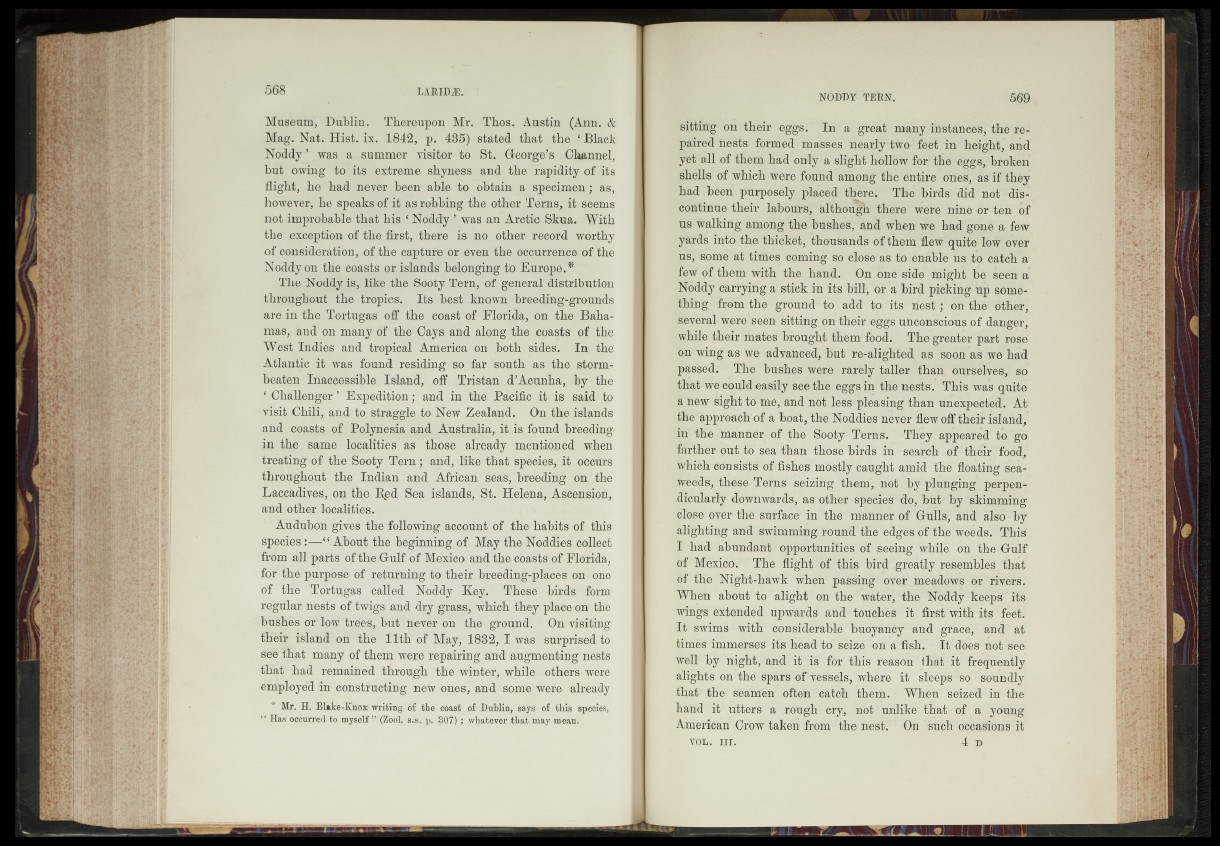
Museum, Dublin. Thereupon Mr. Thos. Austin (Ann. &
Mag. Nat. Hist. ix. 1842, p. 485) stated that the ‘Black
Noddy’ was a summer visitor to St. George’s Channel,
hut owing to its extreme shyness and the rapidity of its
flight, he had never been able to obtain a specimen; as,
however, he speaks of it as robbing the other Terns, it seems
not improbable that his ‘ Noddy ’ was an Arctic Skua. With
the exception of the first, there is no other record '.worthy
of consideration* of the capture or even the occurrence of the
Noddy on the coasts or islands belonging to Europe.*
The 'Noddy is, like the Sooty Tern, of general distribution
throughout the tropics. Its best known breeding-grounds
are in the Tortugas off the coast of Florida, on' the Bahamas,
and on many of the Cays and along the coasts of the
West Indies and tropical America lon both sides. In the
Atlantic it was found residing so far south as the storm-
beaten Inaccessible Island, off Tristan d’Acunha, by*the
‘ Challenger ’ Expedition; and in the Pacific it iss said |o
visit Chi|f, and to straggle to New Zealand. On the islands
and coasjtj of Polynesia and A^gt,ralia, it is found breeding*
in the same localities as those already mentioned when
treatingof theSobtyTern; and, like that species,, it occurs
throughout the Indian and African sjas, breeding on the
Lacca.dives, on the R.ed Sea. islands* St. Helena, Ascension,
and other localities» - -
* Audubon gives the following, account of the habits of this
species ‘ About the beginning of- May tie Coddles cSfect
from all parts:-dffthe Gulf-of Mexico and the coaster of Florida,
for the purpose of l eturning to their breeding-places o A one
of the" Tortugas called Noddy- Key.^ These birds form
regular nests; of.twigs and, dry grass, which they place oh- tfite
bushes'-ordowlrees^bjitrnever on the ground. Oh visiting
fBeir island on the 11th of May,'1882,\ I was surprised to
See that many of them were repairing and augmenting nests
fbS#fiad remained Through the winter*-while others were
employed ih^cohstructing^hew ones/ and some;were 'already
- * Mr. H. Blibke-Knoxfwriting'of the coast ofcDublin, says -bf -this species,
“ Has occurred to myself ” :(Zoot 3Qfc)4 whatever that may mean.
sitting on- their eggs. In a. great many instances' thé repaired
nests formed- masses nearly two feet in height, and
yet all of them had only a slight hollow for the eggs, broken-
shells of which were found among' the entire ones, as-if they
had bèen purposely placed' there. The birds did n o t-dis-,
continue-their labours, although there were nine or -tèn óf
us walking among the bushes, and when we had gonè a few-
yards into the thicket, thousands of them flew quite low ;over
us,' some at times coming So close as to enable us to catch a
■few of them with the hand. On one side might be seen'a
Noddy carrying a stick in its bi®? or a bird picking up something
frem the ground' add to ■ its nest ; on the other,’
several wefexseem sitting Mlihëir eggs unconscious'of danger/
while their mates brought them food. The greatér part rose
on wing as wé advanced, but re-alighted as soon as we had
passed. The bushes-, were rarely taller than ourse-lves, so
that wè could easily see the éggs in the nêsts-. This was quitb-
a new sight to me, and not less-.pleasing than unexpected. i p
the kpprbach’of a boat,'the Noddies never flew off their island/
in 'thë-nfannér of the,-SbSfy*/Terhs. ' They appeared to go'
farther öht’to'sea'-thah'those birds in searéh.. of their .food,
jfhifeh consists' of fis!l'es:mostiyeaught amid the floating seafoods/
These TeMsr-V^ not by-plunging perpendicularly^
downwards, as other'species do, but by skimming
Meso-évér'the surface h r the manner óf Gulls, and also rbÿ
alighting and swimming round thebdghs%f The’wêedfe.'"This
L had'-abundaht opportunities of-, seeing ^bile en the Gulf
Óf'-’Mëxióó? The flight of this bird greatly resembles that
.of The Night-hawk when passing oVer meadows or rivers.
When about £o? alight' on the water, -the Noddy %eeps ' its
.wings extended upwards and touches/4^)' first with- its' feet;
It swims - with- considerable buoyancy'and grace, ■-and at
ifttîès inimerses its head tof seize "bn a fish. It*dBls®âoîb'llér
well by“*mght, and for this reason'"' that it frequently
alights bn-fhë spars ofvessels/ where it- sleéps d l y
thàtj the' seamen‘ often catch them. When seized.- in the
land w fitters a rough cry, not unlike that - of a young
American’ Grow taken from the nest? On 'such occasions if
■Su in. 4 D